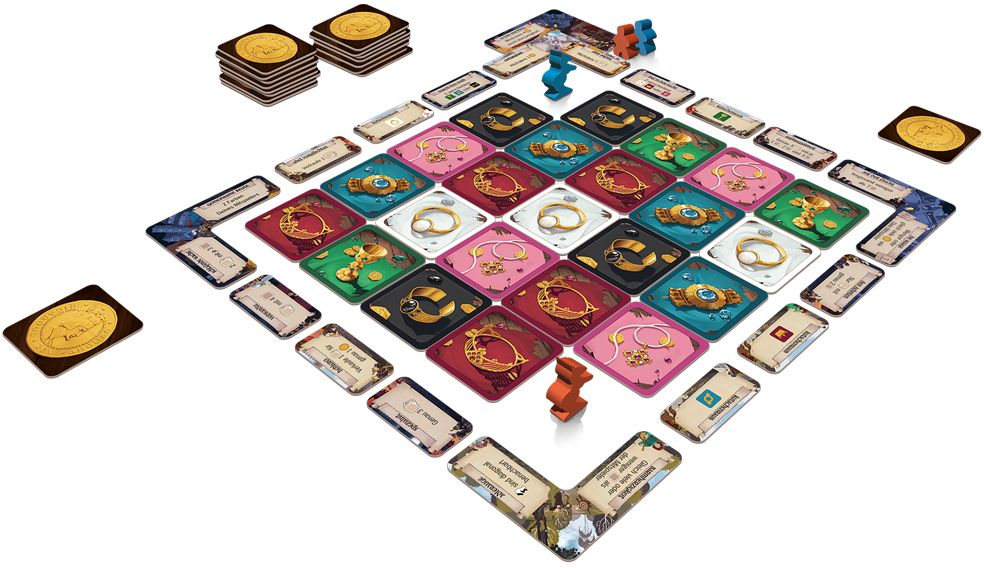Be the Best Heroic Outlaw in Robin of Locksley

The Locksley clan is at odds in this two player duel to determine who is the best Locksley in Sherwood Forest.
Gameplay
Robin of Locksley is a 2-player game in which each player becomes a competing Robin of the Locksley family. In an effort to prove who is the better pauper thief, players will be collecting sets inside a 5-by-5 grid of assorted colored tiles representing the treasures the Locksleys are collecting from the unsuspecting rich who travel through their forest. Each player will take control of a horse pawn, allowing them one knight’s movement per turn to collect one tile per turn and filling the empty space they vacated with a newly drawn treasure tile.
As players collect the variable colored tiles, they will be used to advance a corresponding bard pawn that borders the grid. The bard path is generated randomly from a group of tiles that give a goal for a player’s bard token to advance, with fame (corner) tiles providing other additional challenges as players advance around the track. Also, a goal tile will be added to the outside of the beginning fame tile as part of the game’s conclusion.
The tiles along the bard track require players to collect specific treasure (for example, a black treasure tile before the bard can advance on the track) or move their knight pawn so that it is positioned in such a way to the opponent’s knight pawn. As players move within the grid and collect more treasure, they will be able to meet more difficult challenges on the bard track which may require multiples of one particular treasure tile or collections of varying treasures that meet the requirements.
Some challenges along the bard track will be too difficult to meet quickly, or in a race to advance further during one’s turn, some extra help may be needed. Each treasure tile is double sided, with the inverse featuring a coin. Players begin the game with one coin each, but can gain more by selling off one of their sets if they have accumulated three or more of the same treasure title. Players must return two tiles and may flip over the remaining tiles of that collection to turn them into coins. The more coins a player accumulates, the easier it becomes to move along the bard track without having to worry about the knight pawn being perfectly positioned.
Coins are also important to winning the game. The game is won in one of two ways: completing two laps around the bard track or lapping past the other player. When one player laps the other, the game is finished and the lapping player is declared the winner. However, if a game requires two complete laps of the bard track, players must have 4 coins to also meet the requirements of the goal tile.

Review
Robin of Locksley is a game that allows players to flex a bit of brain power as it unfolds. Even though players are locked into moving the knight pawn once per turn, how the knight is positioned for following turns and the order in which treasure is collected can create a combination that allows their corresponding bard pawn to advance across multiple bard track tiles during their turn.
However, there is a luck component to the game due to what treasure tiles are drawn to fill vacated spaces, as well as the order in which the tiles of the bard track are drawn during any given game. While the coin mechanic allows this to be mitigated, if a player has to sell too many treasures and spend too many coins, they will not be able to meet the goal tile and will snatch defeat from the jaws of victory.
Yet, Robin of Locksley does a good job of capturing the competitive nature of chess in a two player game that plays in no more than 25-30 minutes. And the rules allow for variables that can make a game even shorter. A game with this much variability between plays, set-up, and rules means it is a versatile game that is quick to teach, easy to learn, but always providing a fun challenge in a small package.
Pros: Easy to learn, variable rules and set-up adds depth, simple puzzle elements
Cons: Some luck involved (a downside if you prefer pure strategy games)




